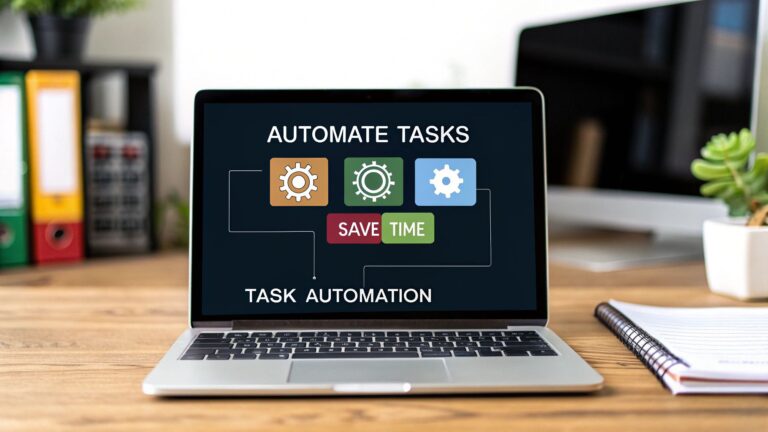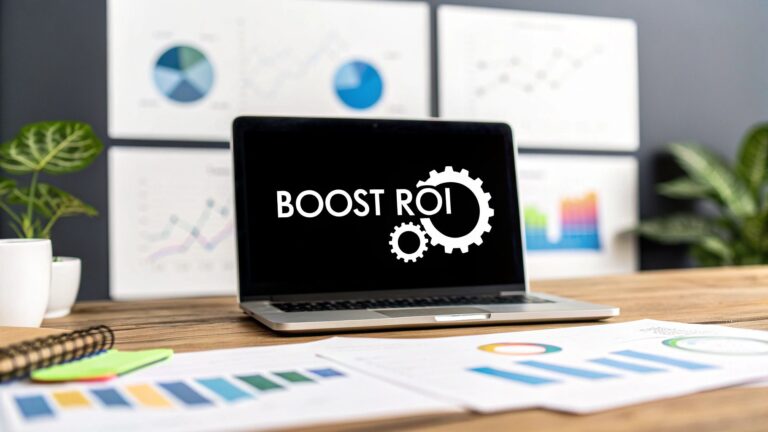10 Powerful Business Automation Examples for 2025
Business automation is no longer a futuristic concept; it's a fundamental strategy for achieving scalable growth and operational excellence. The challenge isn't deciding if you should automate, but determining what to automate and how to do it effectively. Moving beyond generic advice is crucial, as the real value lies in understanding the specific mechanics of successful implementation. This article cuts through the noise to provide a detailed breakdown of tangible business automation examples across critical departments, from sales and marketing to HR and finance.
Instead of just listing tools, we will dissect the underlying strategy and workflow for each use case. You will gain insight into how real companies streamline complex processes, reduce manual errors, and free up their teams to focus on high-impact work. We’ll explore everything from automating lead nurturing sequences in your CRM to optimizing accounts payable and streamlining customer support with intelligent helpdesks.
For businesses looking to implement these concepts, exploring practical guidance like these tips to automate ecommerce operations can provide a solid starting point. Each example in our list is designed to be a blueprint, offering replicable tactics and actionable takeaways you can adapt to your own operational needs, ultimately driving efficiency and boosting your bottom line.
1. Customer Relationship Management (CRM) Automation
Customer Relationship Management (CRM) automation uses software to manage and analyze customer interactions and data throughout the customer lifecycle. This powerful example of business automation streamlines repetitive tasks in sales, marketing, and customer service, such as lead scoring, email follow-ups, and pipeline management. By setting up triggered workflows based on specific customer actions, businesses can deliver personalized, timely communication at scale, nurturing relationships without constant manual effort.

This automation is essential for any business aiming to scale its sales and marketing operations efficiently. It ensures no lead falls through the cracks and that every customer interaction is recorded and leveraged for future engagement. The primary goal is to improve customer relationships, drive sales growth, and increase operational efficiency.
Strategic Analysis & Actionable Takeaways
When & Why: Implement CRM automation when your team spends too much time on manual data entry, lead follow-ups, or segmenting contacts. It's crucial when you need a unified view of the customer journey to prevent disjointed communication between sales and marketing.
Key Insight: The true power of CRM automation isn't just saving time; it's about creating a consistent, data-driven customer experience that feels personal, even when executed at scale.
Actionable Tips:
- Start Simple: Begin with a basic workflow, like an automated welcome email series for new leads, before building complex, multi-stage nurturing sequences.
- Prioritize Data Hygiene: Regularly clean your CRM data to remove duplicates and update contact information. Accurate data is the foundation of effective automation.
- Personalize with Dynamic Content: Use merge tags and dynamic content blocks to tailor automated messages with the recipient's name, company, or recent activity.
- Define Lead Scoring Rules: Establish clear criteria for lead scoring based on your ideal customer profile (ICP). For example, assign higher scores to leads from specific industries or those who visit your pricing page.
2. Accounts Payable and Receivable Automation
Accounts Payable (AP) and Receivable (AR) automation involves using software to manage financial processes like invoice processing, payment approvals, and collections without manual intervention. This form of business automation leverages technologies like Optical Character Recognition (OCR) to scan and extract data from invoices, automatically route them for approval, and schedule payments. It creates a seamless, compliant workflow that drastically reduces the risk of human error and late fees.
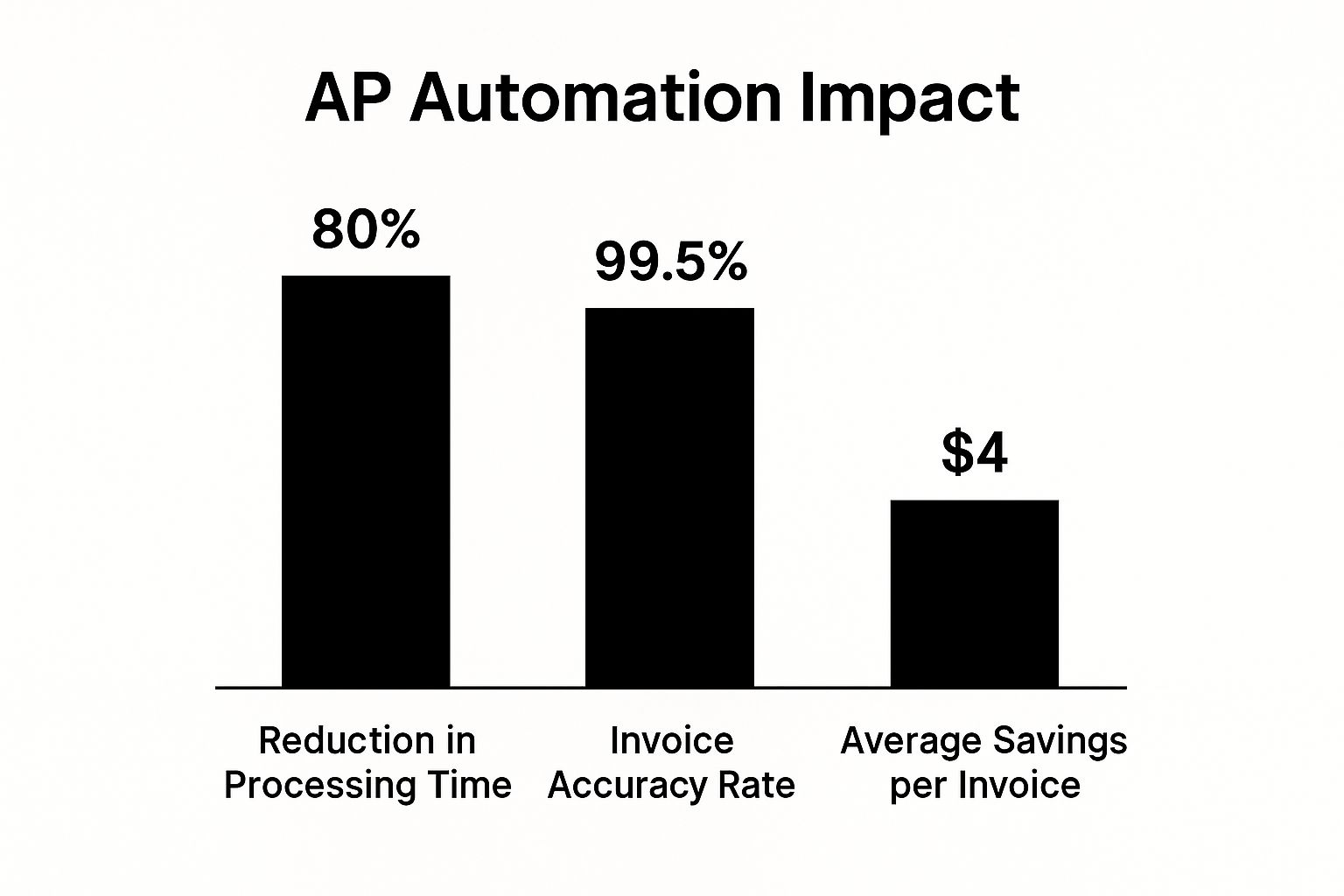
This automation is fundamental for businesses looking to gain control over their cash flow and improve financial accuracy. As shown in the bar chart above, companies can achieve significant gains, such as an 80% reduction in processing time and a 99.5% invoice accuracy rate. Automating these core financial tasks frees up the finance team to focus on strategic analysis rather than tedious data entry. For additional insights into accounting services that can benefit from automation, you might consider resources from Stewart Accounting.
Strategic Analysis & Actionable Takeaways
When & Why: Implement AP/AR automation when your finance team is overwhelmed with manual invoice processing, chasing late payments, or struggling with approval bottlenecks. It is critical for maintaining accurate financial records, improving vendor relationships, and ensuring a healthy cash flow as the business scales.
Key Insight: AP/AR automation transforms the finance department from a reactive cost center into a strategic, data-driven unit by eliminating bottlenecks and providing real-time visibility into financial health.
Actionable Tips:
- Standardize Invoice Submissions: Create a clear policy for vendors on how to submit invoices (e.g., via a dedicated portal or email address) to streamline data capture.
- Establish Clear Approval Hierarchies: Define and configure multi-level approval workflows with specific thresholds in your automation software to prevent payment delays.
- Implement Robust Exception Handling: Develop a clear, automated process for handling exceptions like mismatched purchase orders or incorrect invoice amounts.
- Regularly Audit Processes: Schedule periodic reviews of the automated system to verify accuracy, check for compliance, and identify opportunities for further optimization. Learn more about how to automate invoice processing.
3. Email Marketing Automation
Email marketing automation uses software to send targeted, triggered emails to subscribers based on their specific actions, behaviors, or lifecycle stages. This powerful example of business automation moves beyond simple newsletters, enabling companies to deliver personalized content at scale. Workflows like welcome series for new subscribers, abandoned cart reminders, and re-engagement campaigns run automatically, nurturing leads and customers 24/7.
This level of automation is critical for maximizing the ROI of your email list and building stronger customer relationships. By delivering the right message at the right moment, such as Spotify's personalized playlist emails or Amazon's cart recovery notifications, businesses can significantly boost engagement, conversions, and customer loyalty without manual intervention. The primary goal is to guide subscribers through the customer journey with relevant, timely communication. For more details on this topic, you can learn more about automated email marketing campaigns.
Strategic Analysis & Actionable Takeaways
When & Why: Implement email marketing automation when you need to scale communication without sacrificing personalization. It's essential when manual email sends become too time-consuming, or when you want to capitalize on high-intent user actions, like abandoning a shopping cart or downloading a resource, in real-time.
Key Insight: Effective email automation isn’t about sending more emails; it's about sending smarter emails. It transforms your email list from a static broadcast channel into a dynamic, responsive conversation with each subscriber.
Actionable Tips:
- Segment Your Audience: Create dynamic segments based on purchase history, website behavior, and email engagement. This allows you to send hyper-relevant campaigns that resonate better.
- Focus on High-Impact Flows First: Prioritize setting up a welcome series for new subscribers and an abandoned cart sequence for e-commerce, as these typically yield the highest returns.
- A/B Test Everything: Continuously test subject lines, send times, calls-to-action (CTAs), and content to optimize your open rates and click-through rates.
- Maintain List Hygiene: Regularly remove inactive subscribers and clean your email lists to protect your sender reputation and improve overall deliverability.
4. Inventory Management Automation
Inventory management automation uses software to track stock levels in real-time, predict demand, and automatically reorder products. This system integrates with sales channels, suppliers, and logistics to maintain optimal inventory, a prime example of business automation that prevents costly overstocking or stockouts. By automating workflows for receiving, cycle counting, and replenishment, companies can significantly reduce manual errors and labor costs associated with warehouse operations.
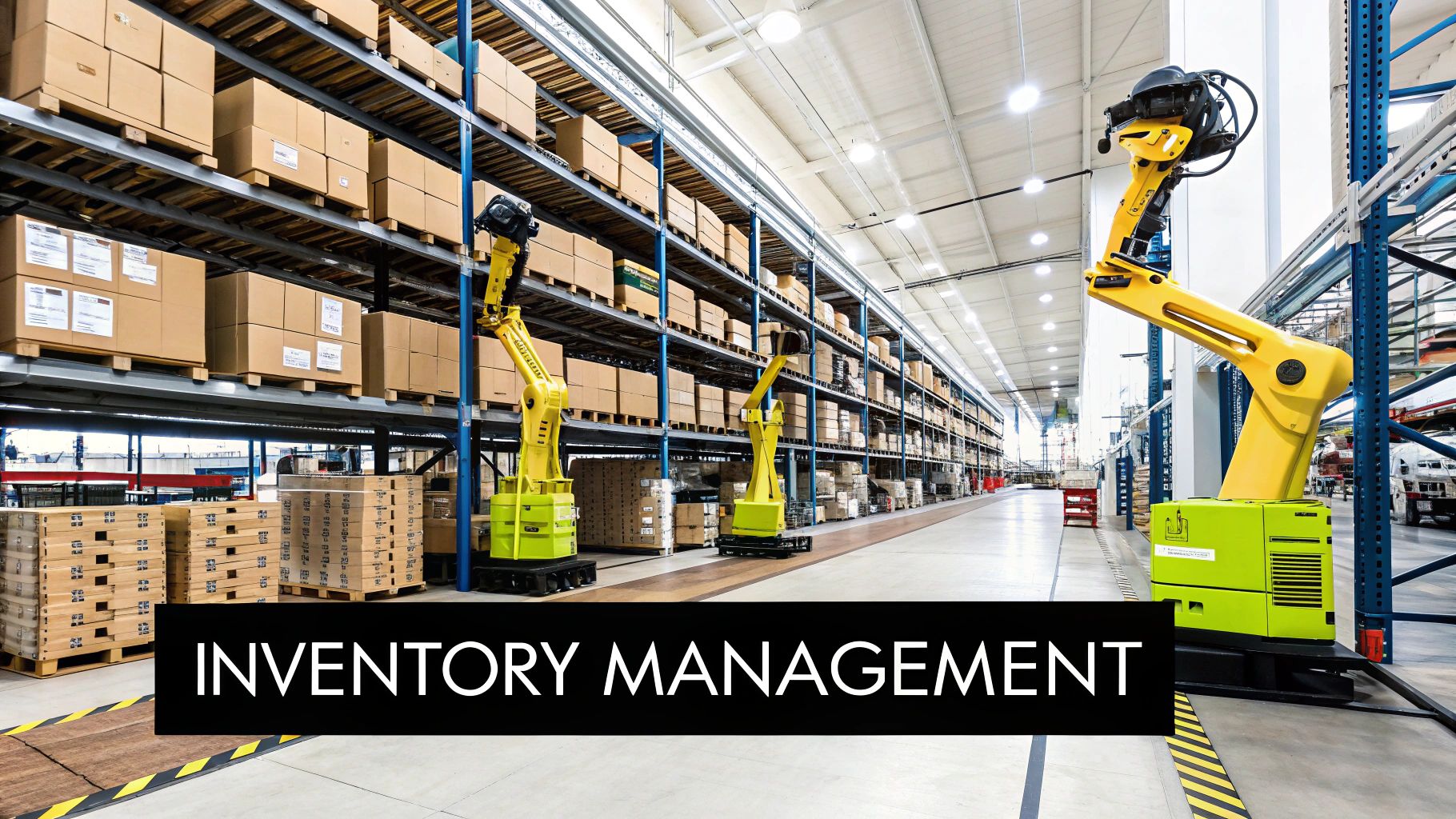
This automation is critical for any e-commerce, retail, or manufacturing business looking to improve supply chain efficiency and profitability. It ensures that capital isn't tied up in slow-moving stock and that popular items are always available, directly impacting customer satisfaction and sales. The primary goal is to balance supply and demand perfectly, minimizing carrying costs while maximizing product availability.
Strategic Analysis & Actionable Takeaways
When & Why: Implement inventory automation when you struggle with stockouts on popular items, excess capital tied up in unsold goods, or high labor costs from manual counting. It is essential for scaling businesses with multiple sales channels or complex supply chains that require a single source of truth for inventory data.
Key Insight: Effective inventory automation goes beyond simple reordering; it transforms your supply chain into a proactive, data-driven asset that can predict future demand and adapt to market changes with minimal human intervention.
Actionable Tips:
- Use ABC Analysis: Categorize your inventory into A (high-value, low-quantity), B (moderate), and C (low-value, high-quantity) items. Prioritize your automation efforts and set stricter controls on category A products.
- Set Dynamic Safety Stock: Instead of a fixed safety stock level, use automation to adjust it based on sales velocity, lead time variability, and seasonality for each product.
- Implement Cycle Counting: Use automated systems to schedule regular, small-scale inventory counts (cycle counting) rather than relying on disruptive annual physical counts, ensuring data accuracy is maintained continuously.
- Integrate with Suppliers: Connect your system directly with key suppliers for automated purchase order generation when stock hits a pre-defined reorder point, streamlining your procurement process.
5. Social Media Management Automation
Social media automation involves using software to schedule posts, monitor brand mentions, track engagement metrics, and curate content across multiple platforms. This valuable business automation example helps maintain a consistent brand presence and frees up marketing teams to focus on strategy and creative work. By automating repetitive tasks like posting content at optimal times, businesses can ensure a steady stream of communication with their audience without constant manual intervention.
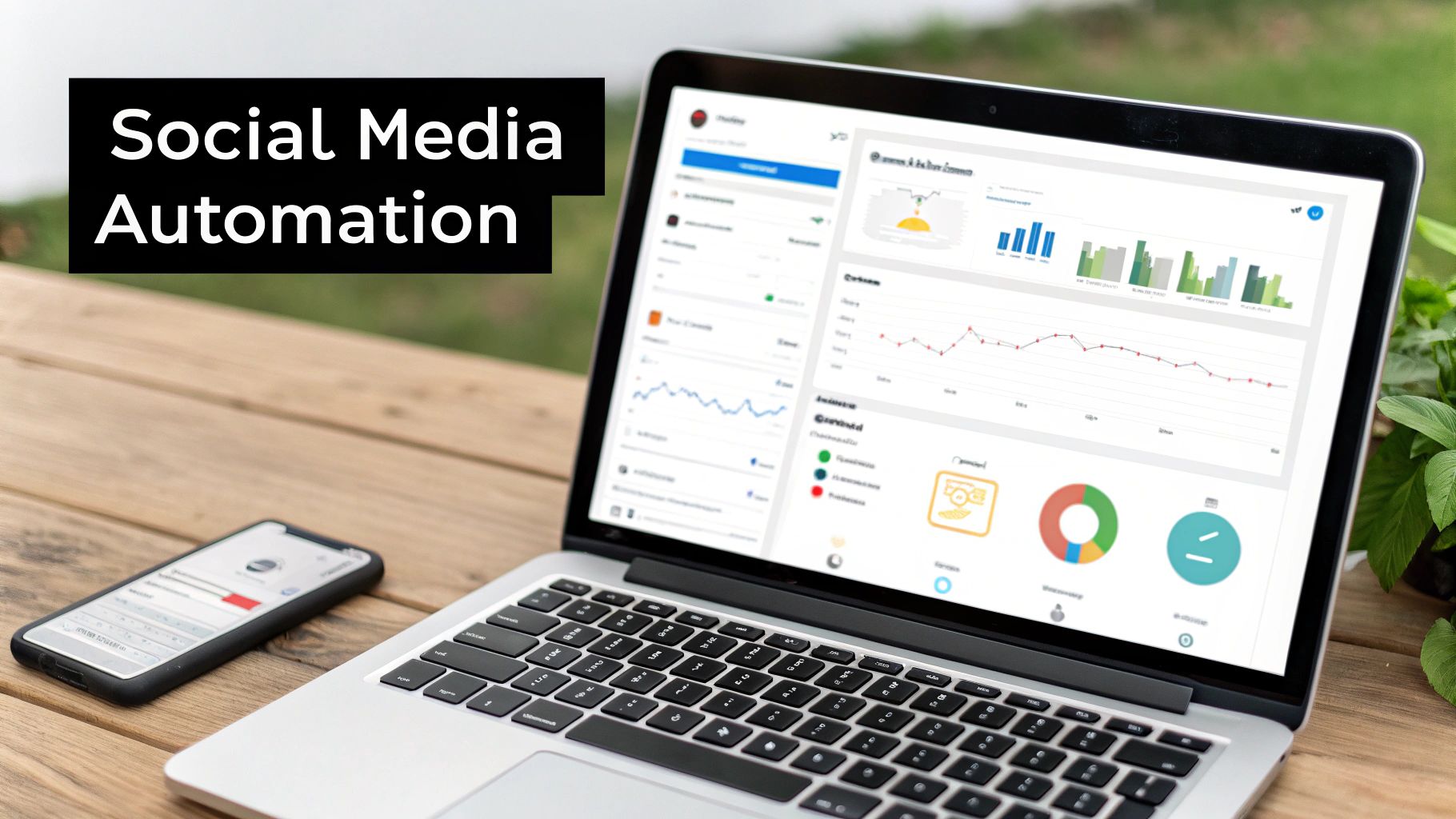
This automation is critical for companies looking to scale their digital marketing efforts and build a strong online community efficiently. Tools like Buffer and Hootsuite enable teams to manage multiple accounts from a single dashboard, analyze performance, and engage with followers more effectively. The primary goal is to increase brand visibility, drive traffic, and foster community engagement while optimizing resource allocation.
Strategic Analysis & Actionable Takeaways
When & Why: Implement social media automation when your team is struggling to post consistently across all channels or spending too much time on manual scheduling and reporting. It's essential when you need to maintain an "always-on" presence to engage with a global audience across different time zones.
Key Insight: Effective social media automation is not about "setting it and forgetting it." It's about using tools to handle the repetitive logistics so your team can dedicate more time to authentic, real-time engagement and strategic content creation.
Actionable Tips:
- Balance Automation and Authenticity: Schedule foundational content like blog posts and promotions, but leave room for spontaneous, in-the-moment posts that reflect your brand’s personality.
- Set Up Keyword Monitoring: Use your tool to monitor brand mentions, competitor names, and relevant industry keywords to identify opportunities for engagement and customer service.
- Analyze and Optimize Posting Times: Use the platform’s analytics to determine when your audience is most active and schedule your posts for maximum visibility and engagement.
- Maintain Human Oversight: While scheduling can be automated, responses to comments and direct messages should be handled by a human to maintain a personal connection with your audience. To find the right solution for your needs, you can explore some of the best social media automation tools.
6. Human Resources and Payroll Automation
Human Resources (HR) and payroll automation involves using software to manage the entire employee lifecycle, from recruitment to retirement. This broad category of business automation examples streamlines critical administrative duties like job posting, applicant screening, employee onboarding, time tracking, payroll processing, and benefits administration. By automating these repetitive, rule-based tasks, HR departments can reduce manual errors and ensure regulatory compliance.
This automation is essential for freeing up HR professionals to focus on strategic initiatives like employee development, talent management, and building a strong company culture. The primary goal is to improve operational efficiency, enhance the employee experience, and maintain meticulous, compliant records with minimal administrative burden. It allows companies like Unilever to screen vast numbers of applications efficiently, a task impossible to manage manually.
Strategic Analysis & Actionable Takeaways
When & Why: Implement HR and payroll automation when administrative tasks consume a significant portion of your HR team's time or when you are scaling your workforce. It's critical for maintaining compliance with complex labor laws and tax regulations, especially as your company grows.
Key Insight: Effective HR automation does more than just process payroll; it creates a consistent and positive experience for employees at every touchpoint, from their first application to their final payslip.
Actionable Tips:
- Start with Payroll: Begin by automating payroll, as it offers immediate ROI through time savings and error reduction, before expanding to more complex areas like performance management.
- Ensure Data Security: Prioritize platforms with robust security measures to protect sensitive employee data and ensure compliance with privacy regulations like GDPR.
- Train Your Team: Provide comprehensive training for both HR staff and employees to ensure they are comfortable using the new systems for tasks like time-off requests and benefits enrollment.
- Audit Regularly: Schedule regular audits of your automated processes to verify accuracy, check for compliance updates, and identify areas for improvement.
7. Customer Support and Helpdesk Automation
Customer support and helpdesk automation uses technology to manage, track, and resolve customer inquiries with minimal human intervention. This powerful form of business automation involves routing support tickets, deploying chatbots for instant answers, and maintaining self-service knowledge bases. By automating repetitive queries and administrative tasks, support teams can focus their expertise on complex, high-value customer issues.
This automation is critical for companies looking to offer scalable, 24/7 support without exponentially increasing headcount. It ensures faster response times and consistent service quality, significantly improving customer satisfaction and retention. The goal is to create an efficient, hybrid support model where technology handles the routine, and humans handle the exceptions.
Strategic Analysis & Actionable Takeaways
When & Why: Implement support automation when your team is overwhelmed by repetitive questions, ticket volume is unpredictable, or you need to provide after-hours support. It's essential for scaling operations while maintaining low first-response times and high customer satisfaction (CSAT) scores.
Key Insight: Effective helpdesk automation isn't about replacing human agents; it’s about augmenting them. It frees up your team's cognitive resources to solve unique problems, turning your support center from a cost center into a customer loyalty engine.
Actionable Tips:
- Start with a Knowledge Base: Before building chatbots, create a robust, searchable knowledge base. This content will become the foundation for all your automated support channels.
- Provide Clear Escalation Paths: Ensure customers can easily switch from a chatbot or automated system to a live agent. A frustrating automated loop is worse than no automation at all.
- Use Ticket Tagging Automation: Set up rules to automatically tag and categorize incoming tickets based on keywords. This helps route issues to the right department and identifies recurring problems.
- Monitor Automation Performance: Track metrics like ticket deflection rate and CSAT scores for automated interactions to ensure the system is genuinely helping customers, not frustrating them.
8. Sales Process Automation
Sales process automation uses software to streamline and automate repetitive, administrative tasks throughout the sales cycle. This powerful form of business automation handles everything from lead qualification and opportunity management to proposal generation and contract processing. By connecting with CRM platforms, these systems guide prospects through the sales funnel, trigger follow-up sequences, and equip sales teams with timely insights and next-best-action recommendations, freeing them up to focus on high-value conversations.
This automation is critical for scaling sales operations and increasing team productivity. It ensures consistent follow-up, reduces quote generation time from hours to minutes, and provides a clear, data-driven view of pipeline health. The primary objective is to accelerate the sales cycle, increase conversion rates, and allow sales representatives to dedicate more time to building relationships and closing deals.
Strategic Analysis & Actionable Takeaways
When & Why: Implement sales process automation when your sales team is bogged down by manual tasks like logging calls, sending follow-up emails, or creating proposals. It's essential when you need to enforce a consistent sales methodology across the team and ensure high-value leads receive immediate, personalized attention without manual intervention.
Key Insight: Effective sales automation isn't about replacing salespeople; it's about augmenting their abilities by handling the administrative burden, allowing them to focus exclusively on the strategic and human elements of selling.
Actionable Tips:
- Map Your Process First: Before automating, thoroughly document every step of your existing sales process to identify the most impactful and repetitive tasks to target.
- Start with Lead Rotation: A simple but effective starting point is to automate lead assignment based on territory, industry, or rep availability to ensure rapid follow-up.
- Automate Proposal Generation: Use tools like Salesforce CPQ or PandaDoc to create templates that auto-populate with CRM data, drastically reducing the time spent on creating quotes and proposals.
- Maintain Human Oversight: For top-tier prospects, use automation to trigger alerts and tasks for sales reps rather than relying on fully automated communication. This blends efficiency with a necessary personal touch.
9. Supply Chain and Procurement Automation
Supply chain and procurement automation uses technology to streamline and manage the entire procure-to-pay lifecycle. This powerful example of business automation handles repetitive tasks like purchase order generation, vendor management, shipment tracking, and invoice processing. By integrating with Enterprise Resource Planning (ERP) systems, it creates a seamless flow of information, from initial requisition to final payment, ensuring compliance and cost control.
This automation is critical for businesses looking to optimize operational efficiency, reduce manual errors, and gain real-time visibility into their spending. It transforms procurement from a transactional function into a strategic one, allowing teams to focus on supplier relationships and negotiation. The primary goal is to minimize costs, mitigate supply chain risks, and accelerate fulfillment cycles.
Strategic Analysis & Actionable Takeaways
When & Why: Implement procurement automation when manual processes are causing delays, creating compliance risks, or limiting your ability to negotiate favorable terms with suppliers. It's essential when you need to enforce spending policies and gain a centralized view of company-wide purchasing activities to identify savings opportunities.
Key Insight: Effective supply chain automation is less about replacing human buyers and more about empowering them with data-driven tools to make faster, smarter, and more strategic procurement decisions.
Actionable Tips:
- Standardize Processes First: Before automating, map out and standardize your procurement workflows. A clear, consistent process is easier to automate and manage.
- Implement Approval Workflows: Set up automated, multi-level approval chains based on spending thresholds or categories to ensure budget compliance without manual chasing.
- Establish Communication Protocols: Use the automated system to manage all supplier communications, from purchase orders to status updates, creating a transparent and auditable record.
- Monitor Supplier Performance: Leverage automation to track key supplier metrics like on-time delivery rates and quality scores, enabling data-backed performance reviews and vendor optimization.
10. Business Intelligence and Reporting Automation
Business Intelligence (BI) and reporting automation involves using software to collect, process, and visualize data from multiple sources without manual intervention. This powerful example of business automation generates real-time dashboards, scheduled reports, and predictive analytics, delivering critical insights directly to stakeholders. By automatically identifying trends, anomalies, and key performance indicators (KPIs), BI systems like Tableau or Microsoft Power BI empower teams to make data-driven decisions faster.
This automation is essential for any modern business that needs to move beyond static spreadsheets and gut feelings. It democratizes data, allowing non-technical users to explore complex datasets and understand business performance at a glance. The primary goal is to provide a single source of truth, improve strategic planning, and uncover hidden opportunities for growth and efficiency.
Strategic Analysis & Actionable Takeaways
When & Why: Implement BI automation when your teams spend hours manually compiling reports from different systems (e.g., CRM, ERP, Google Analytics). It's crucial when you need immediate visibility into business health or want to track complex KPIs across departments without delays.
Key Insight: The true value of BI automation isn't just generating reports faster; it's about creating a culture of proactive, data-informed decision-making where insights are instantly accessible to everyone.
Actionable Tips:
- Start Simple: Begin by automating a single, high-value report, like a daily sales summary or a weekly marketing performance dashboard, before building out a comprehensive BI ecosystem.
- Establish Data Governance: Define clear KPI definitions, business logic, and data sources early on. Consistent, trustworthy data is the bedrock of meaningful analytics.
- Create Clear KPI Definitions: Ensure everyone in the organization agrees on how key metrics are calculated. For example, what exactly constitutes an "active user" or a "qualified lead"?
- Provide Self-Service Training: Empower your team by providing training on self-service analytics tools. This reduces reliance on data analysts for every minor query and fosters broader data literacy.
Top 10 Business Automation Examples Comparison
| Automation Type | Implementation Complexity | Resource Requirements | Expected Outcomes | Ideal Use Cases | Key Advantages |
|---|---|---|---|---|---|
| Customer Relationship Management (CRM) Automation | Moderate (2-6 months setup) | User licenses ($12-$300/month), data maintenance | Increased sales conversions, improved retention | Sales teams, marketing departments | Scales personalized customer interactions, better forecasts |
| Accounts Payable and Receivable Automation | High (complex workflow setup) | High initial cost, staff training | 80-90% faster invoice processing, cost savings | Finance, accounting departments | Eliminates paper processes, improves cash flow |
| Email Marketing Automation | Moderate | Content creation, segmentation effort | 320% more revenue, higher engagement | Marketing, e-commerce | Personalized campaigns at scale, detailed analytics |
| Inventory Management Automation | High | Advanced systems, data accuracy setup | 65% fewer stockouts, 20-50% excess inventory reduction | Retail, warehousing, logistics | Real-time tracking, demand forecasting |
| Social Media Management Automation | Moderate | Content curation, ongoing management | Saves 6-10 hours/week, 25-50% engagement boost | Marketing teams, brand managers | Consistent posting, multi-platform analytics |
| Human Resources and Payroll Automation | High | Compliance updates, staff training | 80% payroll time reduction, 50% faster hiring | HR departments | Compliance improvement, reduced errors |
| Customer Support and Helpdesk Automation | Moderate | Chatbot training, knowledge base upkeep | 90% faster response, 15-25% higher satisfaction | Support centers, customer service | 24/7 availability, reduces staff workload |
| Sales Process Automation | Moderate | Process mapping, ongoing rule refinement | 14.5% productivity gain, 18% shorter sales cycle | Sales organizations | Consistent pipeline management, better forecasting |
| Supply Chain and Procurement Automation | High | Complex integration, supplier cooperation | 70% faster procurement, 10-20% cost reduction | Procurement, supply chain teams | Real-time visibility, improved supplier management |
| Business Intelligence and Reporting Automation | High | Data governance, user training | 90% less report prep time, 60% faster decisions | Analytics, executive teams | Real-time insights, predictive analytics |
From Examples to Execution: Your Automation Roadmap
The journey through these diverse business automation examples, from streamlining sales pipelines to refining HR onboarding, reveals a powerful, unifying truth: automation is not about replacing human ingenuity, it's about unleashing it. We've seen how automating accounts payable frees up finance teams for strategic forecasting and how intelligent customer support bots empower agents to tackle the most complex, high-value inquiries. The core theme is clear: strategic automation handles the repetitive, so your team can handle the remarkable.
These examples illustrate that the most impactful automation isn't just a single tool but a thoughtfully designed system of interconnected workflows. It's the API call that links your CRM to your accounting software, the trigger that moves a lead from a marketing sequence into a sales cadence, and the automated report that delivers critical business intelligence without manual intervention.
Key Strategic Takeaways
As you move from inspiration to implementation, keep these central principles in mind:
- Start with the Pain Point: The best automation projects solve a real, measurable problem. Don't automate for the sake of technology; automate to eliminate a bottleneck, reduce errors, or reclaim valuable time.
- Think in Workflows, Not Tasks: Instead of asking, "What task can I automate?" ask, "What entire process can I streamline?" True efficiency gains come from optimizing the end-to-end journey, as seen in the supply chain and inventory management examples.
- Data is the Fuel: Every automation you build is an opportunity to collect clean, structured data. This data then fuels better decision-making, personalization, and more intelligent future automations, creating a virtuous cycle of improvement.
Your Actionable Next Steps
Feeling inspired by these business automation examples is the first step; turning that inspiration into tangible results is what matters. Here is a simple roadmap to get started:
- Conduct an Automation Audit: Gather your team and map out a key process, like lead-to-close or order-to-fulfillment. Identify every manual step, point of friction, and opportunity for error.
- Prioritize for Impact: You can't automate everything at once. Score your identified opportunities based on two factors: the potential time/cost savings and the ease of implementation. Target a high-impact, low-effort "quick win" first to build momentum.
- Choose the Right Stack: Select flexible, integration-friendly tools that can grow with you. A no-code platform can be a powerful hub to connect disparate apps without extensive development resources.
- Implement and Iterate: Launch your first automated workflow and monitor the results closely. For a deeper dive into practical implementation, consider how to approach setting up marketing automation the right way for e-commerce for a specific, high-value area of the business. Use the data and feedback to refine and improve your system continuously.
Ultimately, the power of business automation lies in its ability to build a more resilient, efficient, and intelligent organization. It creates the operational foundation that allows your business not just to function, but to scale and innovate at a pace your competitors can't match. The examples in this guide are not just case studies; they are a blueprint for your future operational excellence.
Ready to turn these examples into your reality? MakeAutomation provides a powerful, intuitive no-code platform to connect your favorite apps and build the custom workflows your business needs to thrive. Start automating your critical processes in minutes, not months, by visiting MakeAutomation to explore our templates and begin your free trial.





